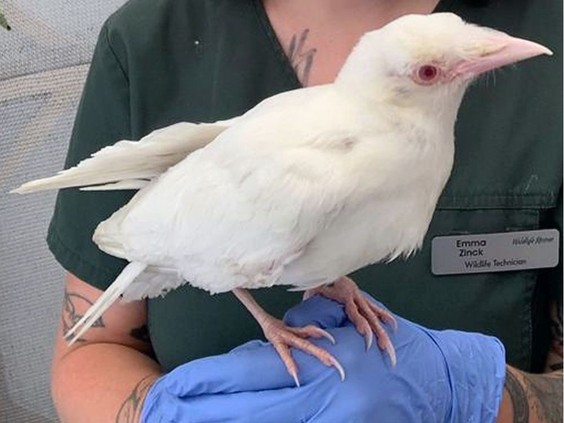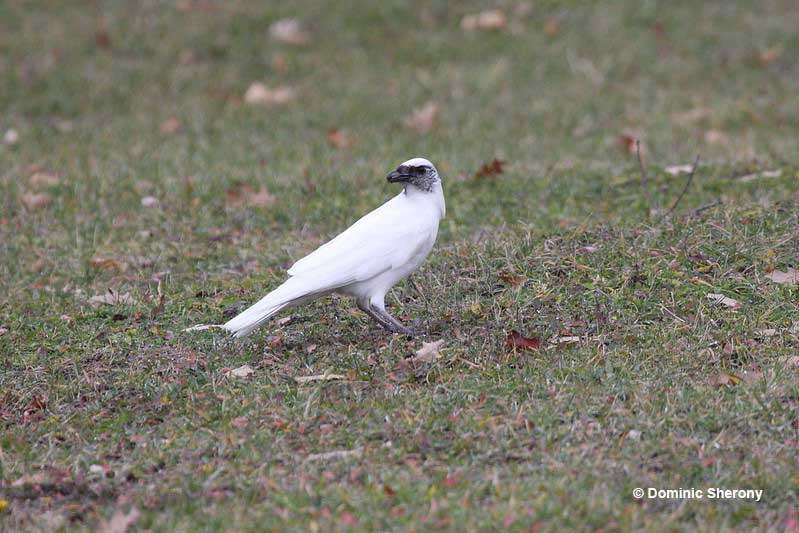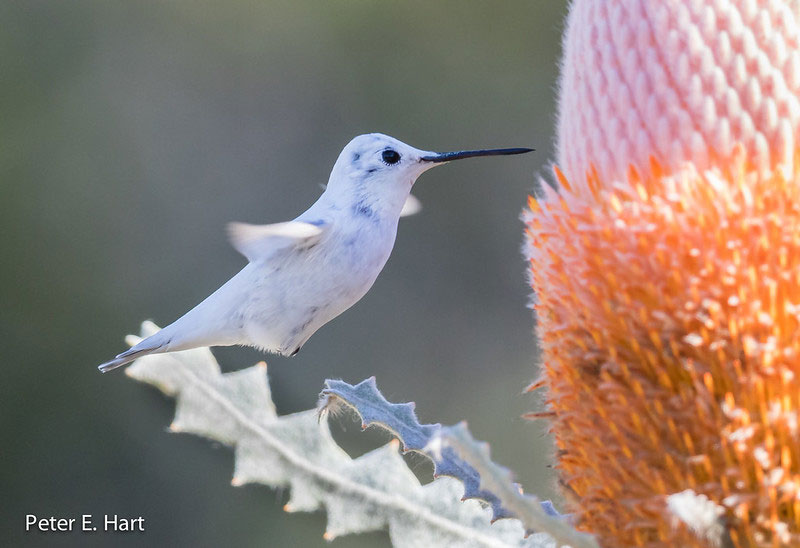
Crows are intelligent and intriguing birds. They can even learn to mimic human words! Almost all of the crows I see have black plumage. However, once or twice, I have seen an all-white crow!
Albino crows are very rare. How does albinism in crows happen? Can they survive in the wild? See answers to these and other questions about albino crows in this article!
On this page
The Power of Mutation
Albinism is a rare but regular occurrence in crows and many other animals. As with all living beings, in crows, the only way true albinism happens is when the bird has a genetic mutation that prevents it from making melanin.
Melanin is the sole factor that gives crows their dark plumage, eyes, beak, legs, and feet. Take that away and the bird has white feathers, reddish or pink eyes, and pale pink skin, legs, and a pale pink beak.

Image courtesy: Vancouver Sun
This occurrence only happens if both parents carry the recessive gene for albinism, and both also happen to transfer that gene to their offspring.
When crows mate, each parent passes one copy of every gene to their offspring. If one of the adults is an albino crow, they would certainly pass the recessive albinism gene to their babies because they carry two copies of that gene.
However, for any baby to be albino, they would still need to mate with either another albino crow, or a crow that carries one copy of the albino gene. That non-albino crow with the gene would have a fifty/fifty chance of passing their recessive copy to their offspring. If the parent passes the dominant, non-albino gene to their offspring, the baby will have black plumage.
Are There Any Black And White Crows?
A few crow and raven species have natural black and white plumage. However, most crows are entirely black. Even so, we do sometimes see crows with white feathers. They can have white feathers in their tails, wings, or scattered on their bodies. These interesting-looking birds are not albinos, nor even partially albino.

If you take a closer look, the crow has a black bill, and its eyes do not appear red. This means this crow is leucistic. © Dominic Sherony
They birds are known as being “leucistic”. This is a term for birds that have some white or pale feathers, or even entirely pale plumage without being albinos. Leucism can happen for a variety of reasons. Different mutations can affect the color of some feathers, and it might also be caused by pollution or pesticides.
Malnutrition or other dietary problems can also result in leucistic birds. Such birds aren’t getting the nutrition they require and thus lack the energy, vitamins, or minerals needed to have normal-colored plumage.
Crows like this are probably unhealthy in general and if several are seen, this could be a sign of a polluted or unhealthy environment.
Although leucistic birds still tend to survive longer than albinos, they don’t usually live as long as normally plumaged individuals. However, unlike albinos, many leucistic birds can regain normally-colored feathers if they live in a clean environment and have a healthy diet.
Are Albino Crows Treated Any Differently?
Albino crows don’t have it easy. Sadly, other crows are quick to recognize that these other birds are different, and they do not treat them well. In the nest, their parents do feed and take care of them. However, after albino crows fledge, they run into problems.
Crows are very social and intelligent birds that constantly communicate with each other. They are very aware of how their fellow crows act and look, and they react to those differences. In the case of albino birds, crows don’t usually stick up for them. Instead they don’t trust those different birds and might even fear them.
It’s hard to know exactly how crows feel about albino members of their species but they certainly don’t accept such birds into their flock. Regularly-plumaged crows drive albinos away or at least to the edge of the flock. They shun them and act as if they don’t want anything to do with the white birds.
Related: What does finding a white feather mean?
In general, even though albino crows could use more help than crows with normal black plumage, other crows don’t usually help them find food. Perhaps some rarely do but typical observations of albino crows are of birds on their own or birds shunned by other crows.
How Long Do Albino Crows Live?
Albino crows don’t live nearly as long as other crows. In fact, most die within their first year. The few that survive to be adults are rare exceptions and probably still don’t live for more than a few years.
Related: Are white peacocks albinos?
These unusual crows have several disadvantages that reduce their lifespan. For one thing, they can’t see as well as other crows.
Since crows need good eyesight to find food and escape predators, this might be the main attribute that seals their fate. Factor in other crows avoiding them nor helping them find food and poor eyesight is probably the main reason why most juvenile albino crows don’t survive beyond their first year.
However, even if they could see well, albino crows are seriously disadvantaged by their bright white plumage. Birds that are easy to see are the easiest ones to catch and an all-white bird is like a constant moving target.

This leucistic hummingbird still has some pigment, but the brilliant white plumage makes it an easy prey for raptors. The same danger applies to crows. © Peter E. Hart
With that in mind, if an eagle or large hawk stalks a flock of crows, the bird they’ll focus on will be the albino. The predator will probably also notice that the albino bird is at the edge of the flock, maybe doesn’t act like the other crows, and is thus easier to catch.
Interesting Facts About Albino Crows
- Albino crows often don’t fly as well as their normally plumaged counterparts. This could be associated with the lack of melanin that normally helps protect feathers from damage caused by UV rays and regular wear and tear.
- Crows with albinism tend to be hyperactive. This behavior may be somehow naturally related to their albino condition.
- To tell if an entirely pale bird is an albino or leucistic, get a good look at its eyes. Albinos always have pink or reddish eyes. Leucistic birds have dark eyes and don’t usually have bright white plumage.
- If you see an albino crow in trouble, call your local wildlife rehabilitator ASAP. Such birds won’t last long in the wild but can be a wonderful teaching resource and a nice addition to a zoo.
- Albinism in crows is caused by a genetic mutation that results in the absence of the tyrosinase enzyme. This protein is required for color pigmentation.
- Albino crows occur in many parts of the world. Although rare, it’s caused by a genetic mutation that happens on occasion and persists in crow populations.
- In some places, albino crows are considered to be good omens and signs of good luck. They can also symbolize purity and honesty.
Albino Crows – Frequently Asked Questions
How rare is an albino crow?
An albino crow is very rare. Only one in 30,000 crows that hatch is albino, and many of those don’t survive to become adults.
What does it mean if you see a white crow?
If you see a white crow, it means you are having a very lucky day. Be aware of rare opportunities and take advantage of your good fortune.
Are albino crows blind?
Albino crows are not blind. However, they may have more problems with their eyesight than non-albino crows.
Have you ever seen an albino crow? Let us know in the comments!

